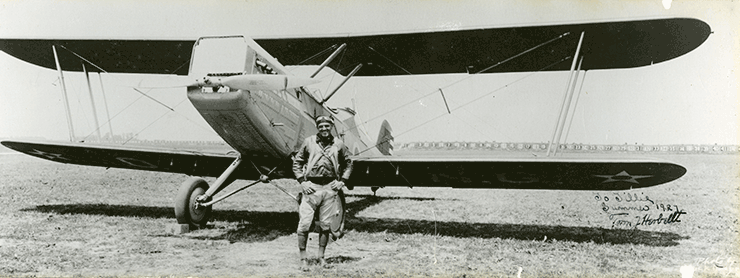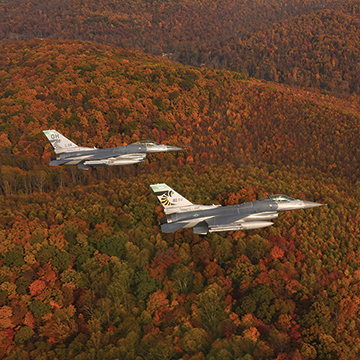Ohio National Guard News
Ohio's place in aviation past, present and futureBy Maj. Gen. Mark E. Bartman, Ohio Adjutant General
|
||
COLUMBUS, Ohio (12/17/16) —The Buckeye State has a lot to be proud of when it comes to our nation’s leadership in aviation. The Ohio National Guard has a rich aviation history, too. Our forbearers were pioneers like Frank Lahm, the nation’s first military aviator; World War I flying ace Eddie Rickenbacker; and the Tuskegee Airmen and Women Airforce Service Pilots of World War II. Ohio's first air unit was an Army unit. The 37th Division Aviation was organized in 1927 at the Central Armory in Cleveland with 101 men but no airplanes or building — those came a year later. Following World War II, the 37th Infantry Division continued to field fixed-wing aviation elements for reconnaissance and artillery observation, eventually converting to mostly rotary-wing airframes. During the Cold War, the 107th Armored Cavalry Regiment fielded attack, utility and reconnaissance helicopters. Today, the Ohio Army National Guard maintains state-of-the-art airframes in the Black Hawk, Lakota and Chinook families. The Ohio Air National Guard’s four wings, located in Columbus, Mansfield, Springfield and the Toledo area, can trace their lineage to historic units. The 180th Fighter Wing dates back to 1917 as an Army supply unit at Kelly Field in San Antonio, Texas. The unit currently flies the F-16 out of the Toledo Express Air National Guard Base and performs the Homeland Aerospace Control Alert mission. The 121st Air Refueling Wing in Columbus began as a fighter unit in World War II, was activated during the Berlin Crisis, and currently has one of the largest military runways east of the Mississippi River — a legacy of the Strategic Air Command under Gen. Curtis LeMay, who was an Ohio State University graduate. The 121st provides KC-135R air refueling support worldwide. The 178th Wing in Springfield also began its service in World War II and boasted the most aces of any fighter group in the Air Force by war’s end. It now carries out a critical intelligence, surveillance and reconnaissance mission for the Air Force. The 179th Airlift Wing in Mansfield also saw fighter service in Europe during World War II, and currently provides airlift capability with a fleet of C-130 Hercules. The unit transports personnel and cargo throughout the U.S. and the world. Ohio’s guard members have answered the call to service with distinction. Lt. Col. Addison Baker was posthumously awarded the Medal of Honor for his heroic part in the Ploesti oil fields bombing campaign during World War II. More recently, Ohio National Guard units have deployed in support of Operation Desert Storm, Operation Enduring Freedom and Operation Inherent Resolve. With 16,000 Soldiers and Airmen — which includes both men and women who wear the uniform proudly — we are the second largest Air National Guard and the fifth largest Army National Guard in the nation. We can land at a bare strip, build a base, lay down its communications and infrastructure, fly in the equipment and personnel to operate it, pay, feed and care for them, develop targeting intelligence, predict the weather over targets, fly the combat sorties to bring the fight to the adversary, and refuel our own combat aircraft. Here in the homeland we stand alert 24/7/365 over 60 percent of the American people to protect against another 9/11 style attack. And we provide assistance to our neighbors in the case of a natural or man-made disaster. We are proud members of our local communities, supporting our neighbors in hundreds of events and tours each year. Ohio’s aviation heritage began with the Wright Brothers and continues today at Ohio National Guard locations across the state as your Soldiers and Airmen prepare for their next mission to serve their communities, their state and their nation. |
||
Maj. Gen. Mark E. Bartman is the Ohio adjutant general. He is a member of the governor’s cabinet and is responsible for the command of the Ohio National Guard and the military readiness of the Ohio Militia. The Ohio National Guard consists of the Ohio Army National Guard, Ohio Air National Guard, Ohio Military Reserve, and Ohio Naval Militia, totaling more than 16,000 personnel. EDITOR’S NOTE: A presidential proclamation marks Dec. 17 as Wright Brothers Day, to commemorate the date in 1903 when Ohio brothers Orville and Wilbur Wright made the first successful flights in a heavier than air, mechanically propelled airplane near Kitty Hawk, North Carolina. |
||
|
|
||

